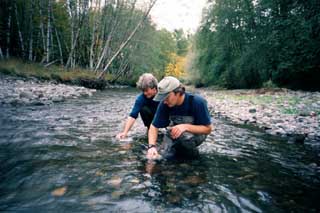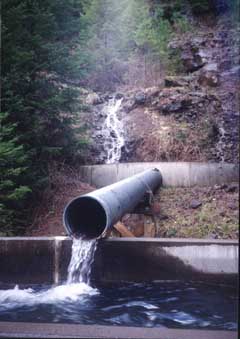
Surveys
DJC.COM
July 12, 2001
Dams vs. fish? Mediate it!
Triangle Associates

Schwennesen |
Good news is rare today when we talk about dams, fish, energy or the environment. It is doubly welcome when there is good news about them all. Mediation requires tireless commitment, creative footwork and willingness to rely on laughter when all avenues of logic are exhausted. Mediation can get hydropower projects licensed more efficiently, and can get environmental improvements on the ground fast, using funds that would otherwise be spent in litigation.
Last month, Oregon Gov. John Kitzhaber announced a mediated agreement to resolve disputes in the relicensing of PacifiCorp’s North Umpqua Hydroelectric Project. He signed the settlement agreement because it will “protect the North Umpqua River and its prized salmon and steelhead while maintaining a valuable source of low-cost hydroelectric generation that this region badly needs right now.”

Scientists assess spawning gravel conditions behind Soda Springs Dam in the North Umpqua watershed in Oregon. |
The agreement protects the North Umpqua Hydroelectric Project’s generating capability, allowing it to serve 78,000 residential customers each year. The project will continue to provide power during peak energy demand.
At the same time, the agreement contains detailed, negotiated environmental improvements that will move the North Umpqua project toward current environmental standards. Many of these measures are set to begin right away, bringing tangible benefits to the watershed even before the license is reissued.
According to Harv Forsgren, regional forester for the USDA Forest Service, which manages most of the land affected by the North Umpqua Project, the agreement will begin to “reweave the fabric of the North Umpqua watershed — thread by thread.”
On June 13, there was a sense of accomplishment and relief in the room as representatives of eight state and federal agencies, and PacifiCorp, reached consensus on the agreement and signed the final document. The agencies included Gov. Kitzhaber’s office; Oregon Departments of Environmental Quality, Fish and Wildlife and Water Resources; U.S. Fish and Wildlife Service; National Marine Fisheries Service; USDI Bureau of Land Management; and the USDA Forest Service.
The road to the settlement agreement had been long and far from straight. PacifiCorp’s efforts to relicense the roughly 50-year-old North Umpqua Project started in winter 1991, almost a decade ago. (The license expired in 1997. After that, operations continued under one-year renewals.)
Since the dam’s first license was issued in the late 1940s, many new environmental laws and regulations had been adopted — like the Clean Water Act, the Endangered Species Act and the Federal Power Act — changing the regulatory and political landscape. Issues to be dealt with had become far more complex and wide-ranging than the number of megawatts of power the project would generate. Concerns about fish access to portions of the river and fish habitat throughout the project were central issues.
These laws also changed the number of participants in the relicensing discussions. Federal and state agencies now had responsibilities for implementing the environmental laws and they needed to be involved. Numerous environmental organizations advocated for the interests they represented.
Discussions over many complex issues continued, often haltingly and with occasional changes in the parties, over the next nine years. During that time, pressures on participants intensified as talk of energy shortages in the West became prevalent, on the one hand, and salmonid species were listed as endangered in rivers up and down the West Coast, on the other.
In an enlightened approach to negotiations, PacifiCorp conducted a watershed analysis in cooperation with the other parties to establish a solid scientific foundation for determining the terms of the relicensing agreement. Even so, by the end of the decade, despite their best efforts, the parties acknowledged they were at a stalemate.
Last summer, the parties agreed to try mediation to reach agreement and Seattle’s Triangle Associates was selected to direct the negotiations. Mediation began in July 2000. The original contract was renewed several times as the parties could see progress and began to develop confidence that they could reach agreement with enough hard work, information sharing and commitment.
What accounts for their ultimate success? As a neutral mediator whose job was to design and guide the work so negotiations could be productive, I believe they succeeded because they used a solid scientific base, agreed on clear goals up front and developed mutual respect. Towards the end it felt like they were fighting fires together as one crew. The negotiators understood the extent to which fish, power generation, and people could gain or lose. The job had to be done. The climate became such that failure to find the best, balanced solutions would have been a personal failure for each individual involved.
Specifically, I credit:
- A scientific foundation built on the results of a watershed analysis by Stillwater Sciences of Berkeley, Calif., provided a factual base for negotiations. This proved to be an anchor for the discussions.
- Resource management goals set the standards an agreement would have to meet. Parties agreed up front that both environmental resources and power generation would be protected to the maximum extent possible.
- Respect for each other’s responsibilities as caretakers of the public trust, the environment, energy production and ratepayer costs allowed tough and productive discussions to take place without extreme gamesmanship.
- A work group of attorneys, each representing a party to the agreement, hashed out implementation issues with Stoel Rives. As painstaking as this was, the lawyers’ negotiations and Stoel Rives’ professionalism were crucial to reaching a final agreement.

Photos courtesy of PacifiCorp Collection of up-slope drainage into a fish creek.
|
Most of the effective problem solving occurred in small policy, scientific, legal and operational work groups. Lead negotiators for the nine parties served as an executive group to resolve policy issues and guide other work groups. Issue-oriented work groups were formed with specialized professionals from each negotiating team. These knowledgeable people worked elbow-to-elbow with their colleagues from other negotiating teams. They tamed complex, unwieldy issues and creatively uncovered informed, fair and long-term solutions that would have eluded any one individual.
It was tough going, and everyone had to compromise on something. But the negotiators were able to build a package that reaches key environmental thresholds and retains the economic capacity to generate power. The settlement agreement responds to the reality that the economy and the environment are not mutually exclusive.
A significant precedent set here is that four federal agencies, four departments of the state of Oregon, the Governor’s office, and PacifiCorp now have a track record of working successfully with each other. This is a rare national example of a relicensing agreement being reached based on consensus. As a result of their work together, these professionals now better understand and respect each other’s responsibilities. They also built a measure of trust and goodwill that comes from knowing each other as warm-blooded human beings. That understanding and trust, in turn, will improve the quality and efficiency of carrying out the details of the agreement on the ground in the North Umpqua watershed.
For more information about the mediated North Umpqua hydropower settlement agreement, visit the Triangle Associates Web site at www.triangleassociates.com. To learn more about how mediation can help reach agreements when complex, contentious issues must be resolved, contact Triangle Associates at (206) 583-0655.
Lois Schwennesen is a mediator who specializes in natural resource issues. She is vice president of Triangle Associates in Seattle.
Other Stories:
- Pesticide-free parks teach new lessons
- Water metering: the debate trickles on
- Studies sniff out Tacoma smelter plume
- Tree investment brings cities many happy returns
- From wood preservation to site remediation — the Cascade Pole cleanup
- New rules for birds, bogs and bulldozers
- Isolated wetlands ruling creates confusion
- Environmental metamorphosis on the Duwamish
- Mitigation banks balance habitat, development
- New Pin Foundation minimizes site impacts
- Bringing a city stream back to life
- Knitting a trail of green
- Stormwater problems? Put a LID on it
- More brownfield incentives in the pipeline
- SEPA document trends since GMA and regulatory reform
- Construction faces new foe: toxic mold
- Helping environmental groups to get wired
- Frequently asked ESA questions
- Muddy waters: The new 4(d) salmon rule
- Global climate change starts at home
- At EPA, next 4 years won’t be boring
- 'House calls' help firms to conserve
- Building a greener future on Bainbridge
- Power users, producers turn toward the sun
- Seattle goes climate neutral
- Bamboo’s popularity shoots up
- Tiny town recycles Goliath proportions
- MTCA revisions take effect Aug. 15
- Environmental education: Knowing what’s in your backyard
- Bear Creek roars again
- Shedding light into the permit ‘black hole’
- UW Bothell — a wetland lesson in the making
Copyright ©2009 Seattle Daily Journal and DJC.COM.
Comments? Questions? Contact us.